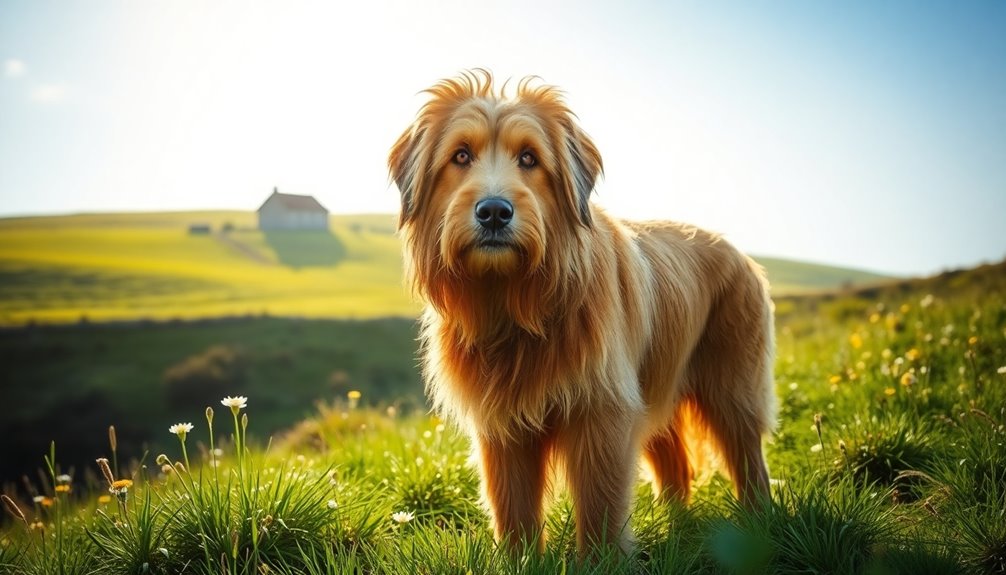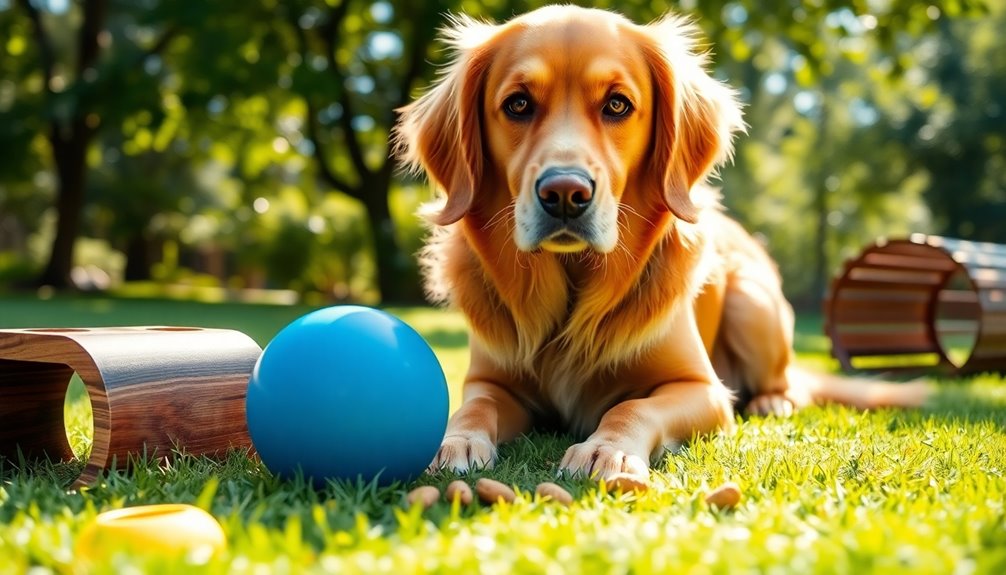To make every day a fun day for your dog, mix physical activities with mental challenges. Start with outdoor adventures like hiking or trips to the dog park. Incorporate indoor games like Hide and Seek or create an obstacle course with household items. Use puzzle toys like Kongs for a tasty mental workout. Stick to a consistent routine that includes regular potty breaks and playtime. Remember to bond through training sessions and socialization with other dogs. With a variety of activities, your dog will stay engaged and happy. Stick around to discover even more fun ways to brighten your pup's day!
Key Takeaways
- Incorporate daily mental stimulation through DIY games like Hide and Seek, puzzle toys, and scent work to keep your dog engaged.
- Create a varied exercise routine with indoor obstacle courses, outdoor adventures, and agility games to maintain physical fitness and fun.
- Establish a structured daily schedule for walks, meals, and potty breaks to provide consistency and predictability for your dog.
- Engage in regular training sessions and socialization opportunities to strengthen your dog's skills and enhance their behavior with other pets and people.
- Dedicate time for bonding through relaxation activities, cuddling, and gentle petting to foster a deep connection with your dog.
DIY Games for Mental Stimulation
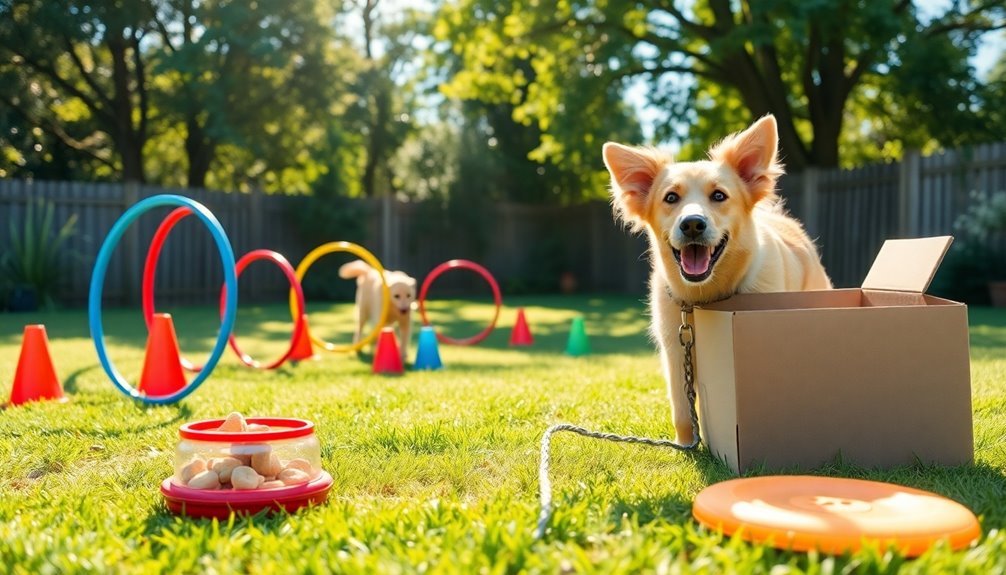
When it comes to keeping your dog mentally stimulated, DIY games can be a fantastic way to engage their natural instincts while having fun together. One popular game is hide and seek. Simply hide treats or toys around your home and encourage your dog to find them, tapping into their hunting instincts. Regular outings to parks for socialization can also enhance your dog's adaptability while playing these games.
You can also create treasure hunts using empty containers like shoeboxes, baiting them with smelly treats for a rewarding challenge. Using empty containers like shoeboxes can also be a great way to create a fun scent game for your dog as they search for hidden treats.
For a twist, try the shell game. Place treats under plastic cups or in a muffin tin, and let your dog figure out how to uncover them. Consistency in commands is essential to help your dog understand the game.
Another great option is to fill cardboard boxes with crumpled newspaper and treats, prompting your dog to dig through to discover their prize.
Puzzle toys are a fantastic addition to your DIY repertoire. Fill a Kong toy with peanut butter and freeze it for a long-lasting challenge.
Treat-dispensing toys and snuffle mats can also keep your dog engaged and entertained.
Indoor Obstacle Course Ideas

Creating an indoor obstacle course for your dog can be a thrilling way to keep them active and entertained, especially on days when outdoor play isn't possible.
Start by building tunnels using dining chairs draped with a large blanket or opt for collapsible fabric tunnels. Cardboard boxes can also be transformed into fun tunnels—just cut out both ends.
For hurdles, set up jumps using a light pole supported by laundry baskets or small foot stools for your dog to leap onto and down from. Begin with low jumps to build confidence, then gradually increase the height.
Next, design a zig-zag course with small obstacles like boxes or chairs. Guide your dog through using treats and verbal commands. Incorporate stairs for a challenging element, and add low tables for them to crawl under. This is particularly beneficial for their fitness and helps improve their physical health.
Lastly, consider using ramps or A-frames for climbing, ensuring non-slip surfaces for safety. To add variety, include pause tables where your dog must hold a position for a few seconds, or even teeter-totters to test their balance.
This indoor obstacle course will keep your dog engaged and physically stimulated!
Fun Hide and Seek Activities
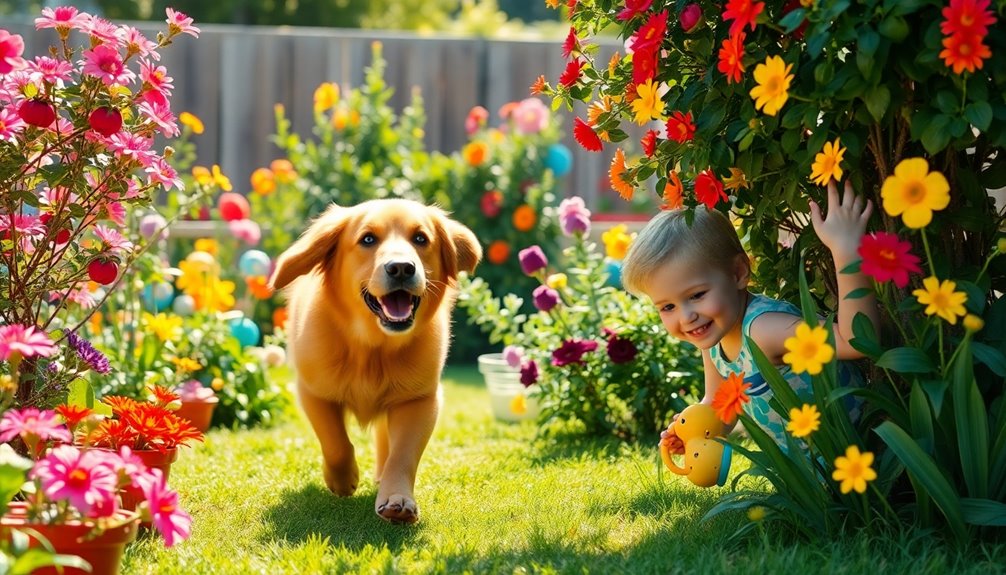
Hide and seek isn't just a childhood game; it's a fantastic way to engage your dog's mind and senses. To start, choose treats or toys your dog loves and ensure they've a solid recall command. Begin with easy-to-find hiding spots like behind furniture or under blankets to build their confidence. Use a consistent cue, like "Find it," to kick off the game. Additionally, you can hide treats in toilet paper tubes to make the search even more exciting. Regular grooming can also help minimize the amount of pet hair that may be left behind during play.
As your dog masters the basics, gradually increase the difficulty. Hide items in more challenging locations, such as higher shelves or within closets. You can also hide multiple items at once to extend the fun and boost mental stimulation.
If you're feeling adventurous, take the game outdoors. Start in your yard, hiding behind bushes, and gradually explore more complex environments like dog parks.
For advanced play, try hiding in different rooms or even levels of your home, using subtle cues instead of verbal commands. Incorporate distractions to mimic real-life scenarios where your dog would need to find you.
Remember to praise and reward your dog when they find you or the hidden treats; this reinforces the game and keeps them engaged.
Engaging Stair and Vertical Games
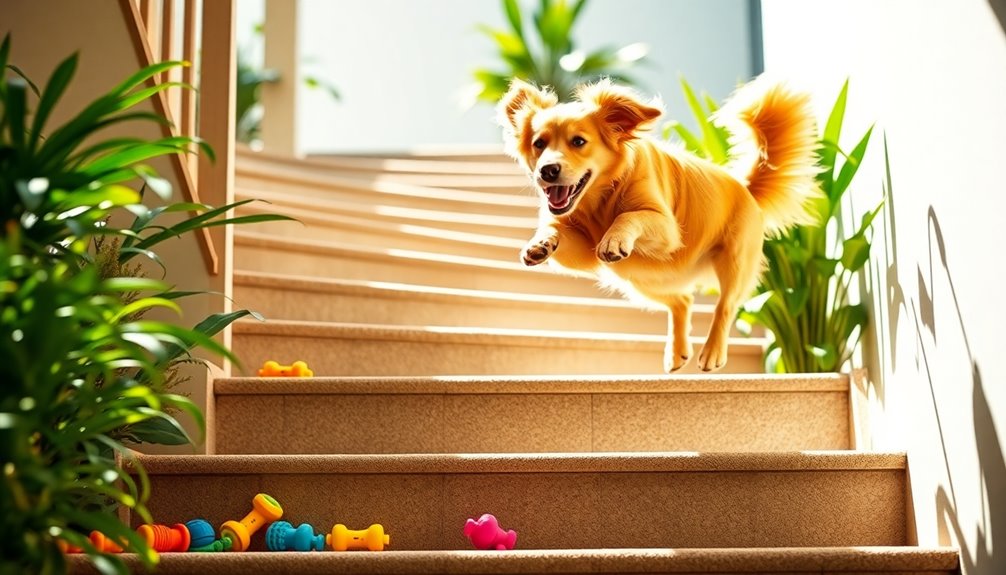
Stairs can be a thrilling playground for your dog, offering both physical exercise and mental stimulation. You can start with a fun Staircase Run, racing your pup up and down while ensuring you're cautious to prevent any slips. For a twist on fetch, try Stair Fetch—throw a toy to the top of the stairs and watch your dog race to retrieve it. Just be mindful of your dog's age and health; avoid these games with older dogs or those with joint issues. Engaging in these activities not only strengthens their muscles but also promotes mental stimulation through problem-solving.
If your dog needs a gentler approach, consider modified stair games. Use a short leash to guide them in a slow fetch or low-impact activities. Always choose carpeted stairs to minimize the risk of falls, and keep sessions short to prevent exhaustion. You can also enhance the fun with vertical obstacle courses indoors. Set up items like chairs or boxes for your dog to navigate through. Incorporate weave poles made from household objects to create agility challenges. Regularly change the course to keep your dog engaged and entertained. Remember, supervision is key—watch for signs of fatigue and prioritize your dog's safety at all times.
Sensory and Sniffing Challenges

Dogs often thrive on sensory and sniffing challenges that tap into their natural instincts. You can create engaging activities right at home to keep your dog mentally stimulated. Try hiding treats around the house for a fun game of hide and seek. Mix it up by placing treats in different spots to maintain interest. Scent work games, like 'which hand' or muffin tin puzzles, can also enhance their sniffing skills. Additionally, be aware that aging dogs may experience sensory decline, which can affect their engagement in these activities. Providing high-quality nutrition is essential for supporting their overall health and energy levels.
When you're out for walks, allow your dog to explore and sniff freely. Designate certain areas for this to encourage natural exploration.
You can also set up indoor obstacle courses that incorporate scent work, combining physical and mental challenges.
For an exciting twist, hide treats in cardboard boxes and let your dog search for them. This promotes problem-solving and sniffing skills.
Always be mindful of your dog's sensory needs. If you notice signs of anxiety or sensory overload, adjust their environment to create a calm space.
Active Physical Games to Enjoy
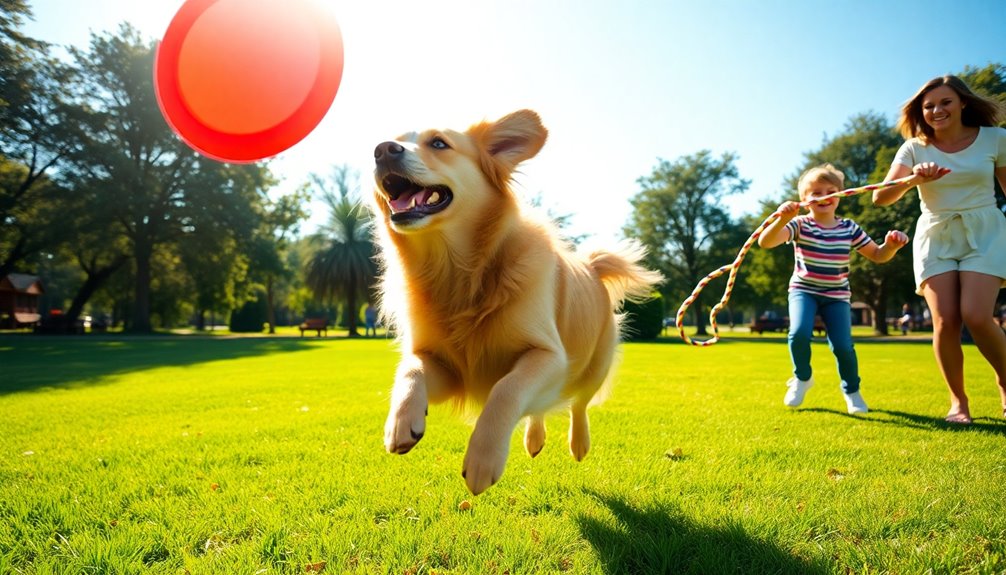
Active physical games can keep your dog both entertained and healthy. Setting up agility and obstacle courses at home can be a fun way to improve your dog's coordination. Use folding chairs, cones, or even toilet plungers to create weave poles. Additionally, incorporating interval training into your sessions can further enhance your dog's physical fitness. It's important to keep in mind that regular grooming can help maintain your dog's comfort and agility during these activities.
For an indoor adventure, arrange cushions and tunnels to enhance agility. If you have older dogs, try a Cavaletti course with broomsticks spaced a foot apart.
Fetch is another fantastic choice. Toss a ball or frisbee while you perform exercises like burpees or push-ups, turning retrieval into a workout for both of you. For added fun, use stairs—throw a toy up the stairs for your dog to fetch back down.
Outdoor activities are equally engaging. Go hiking on dog-friendly trails, ensuring you carry water and take breaks. Swimming offers a low-impact workout that keeps your dog cool, while a dog run provides a safe space to play freely.
Combine these games with hide-and-seek using toys or treats to challenge your dog's cognitive skills. With these active games, you'll foster a fun and healthy environment that your dog will love!
Building a Daily Routine
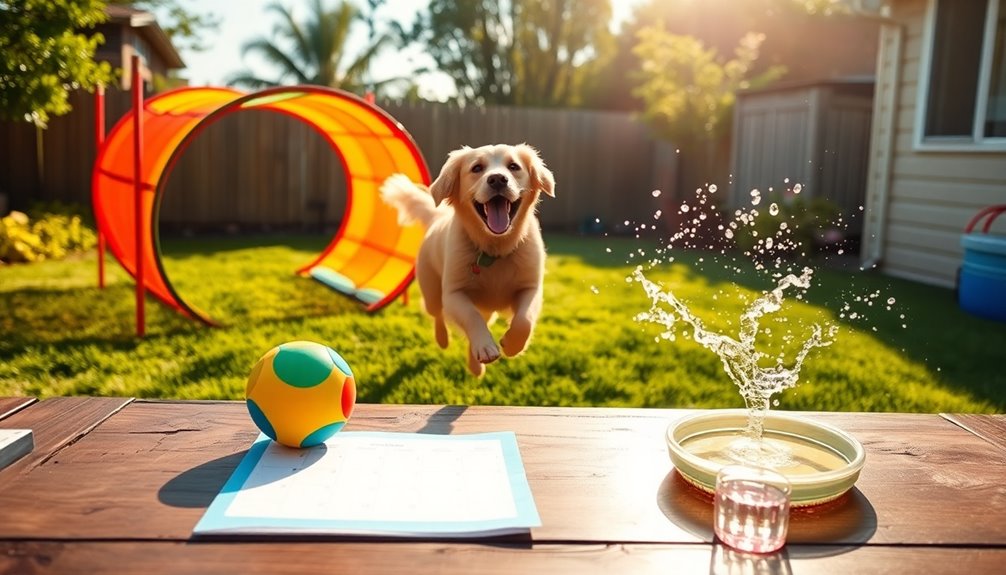
Creating a daily routine for your dog not only helps establish structure but also fosters a sense of security and happiness.
Start your morning by waking up at 7:00 AM and taking your pup for a brisk walk or potty break. Follow this with a short training session, practicing commands like "sit" before breakfast. Consistency is key; feed your dog at the same time each day to regulate their meals and bowel movements. Incorporating structured training sessions can enhance your dog's learning and responsiveness.
Throughout the day, plan for regular potty breaks—every 6-8 hours for adults and every 2-4 hours for puppies. After meals, allow your dog to settle for about 30 minutes before taking them out again. This routine aids in understanding their elimination needs, which is crucial for effective housebreaking.
In the evening, incorporate a 20-minute walk, followed by dinner at the same time each night.
Make time for play and relaxation, whether that's cuddling or playing games.
Finally, prepare for bedtime with a last potty break and ensure your dog's sleeping area is quiet and comfortable.
Frequently Asked Questions
What Toys Are Best for My Dog's Playtime?
When choosing toys for your dog's playtime, consider their personality and play style.
Durable toys like the West Paw Zogoflex Qwizl or the Project Hive Ball are perfect for fetch and chewing.
For mental stimulation, interactive puzzle toys like the Outward Hound Hide a Squirrel can keep them engaged.
Don't forget sensory toys like snuffle mats, which encourage natural foraging behavior.
Mixing different types will keep playtime exciting and fulfilling for your furry friend!
How Can I Tell if My Dog Is Bored?
If you're wondering how to tell if your dog is bored, watch for signs like excessive barking, whining, or pawing at you for attention.
Destructive behaviors, such as chewing furniture or digging, can also indicate boredom.
Additionally, restlessness like pacing or running in circles may signal your dog's need for stimulation.
Keep an eye out for these behaviors, and you'll better understand your dog's emotional state and needs.
How Much Exercise Does My Dog Need Daily?
Your dog needs at least 30 minutes to 2 hours of exercise daily, depending on age, breed, and health.
Active breeds often require over an hour, while older or less active dogs may need shorter, gentler sessions.
Break it up into multiple walks and playtime throughout the day for optimal results.
Don't forget mental stimulation, like training or puzzle toys, to keep their mind engaged and happy alongside their physical activity.
Are There Dog-Friendly Activities for Rainy Days?
Absolutely, there are plenty of dog-friendly activities for rainy days!
You can play hide and seek with treats, engage in a fun tug-of-war, or practice indoor fetch.
Puzzle toys are great for mental stimulation, and teaching new tricks can strengthen your bond.
If you want some extra fun, try chasing non-toxic bubbles or creating an indoor agility course.
These activities will keep your dog entertained and active, no matter the weather!
How Can I Safely Introduce New Games to My Dog?
To safely introduce new games to your dog, start with age-appropriate activities that match their energy level and health.
Begin with simple games like fetch or tug-of-war, using familiar toys to ease them in. Use positive reinforcement like treats and praise to encourage participation.
Pay attention to your dog's reactions; if they seem stressed, switch things up. Gradually increase the game's complexity as your dog gains confidence and enjoys the experience.
Conclusion
Making every day a fun day for your dog is all about creativity and engagement. By incorporating DIY games, obstacle courses, and sensory challenges into your routine, you'll keep your furry friend mentally and physically stimulated. Don't forget to mix in some hide and seek or active play to keep things exciting! By building a consistent routine filled with varied activities, you'll strengthen your bond and ensure your dog enjoys every moment with you. Happy playing!


